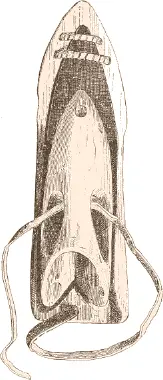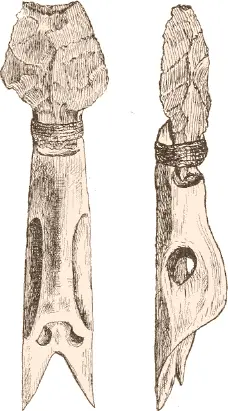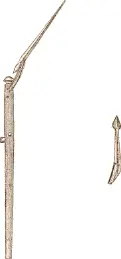
Fig. 419. Qatirn or ivory head of harpoon shaft. (National Museum, Washington. 34101.) ⅔

Fig. 420. Manner of attaching the two principal parts of the harpoon.
The tusk and the qatirn are fastened to each other in a most ingenious way, which may be readily made out from the engraving (Fig. 420). The principal effect of this arrangement of the holes and the thong is that the tusk is kept steady by two parallel thongs that prevent it from tipping over and only allow a movement in the plane of the flattening of the shaft as soon as any considerable force is applied to the tusk.
The harpoon head used in connection with this weapon is the tokang. To prevent it from being injured, it is carried in a wooden sheath (Fig. 421). The iron point is secured by a string of whalebone or sealskin; the lower part is fastened to the sheath as indicated in the figure. The tokang differs from the naulang in that it is larger and stouter. In some cases great care is bestowed upon the finishing of this important weapon.

Fig. 421. Tokang or harpoon point in sheath. (In the possession of Captain John O. Spicer, Groton. Conn.) ⅔

Fig. 422. Tokang or harpoon head taken from a whale in Cumberland Sound. (National Museum, Washington. 34069.) ⅔
An interesting specimen of this variety of harpoon head was found by Kumlien in Cumberland Sound (Fig. 422). It was taken from a whale and differs from the device of that country. The back is bent similar to that of the iron naulang and the barbs have two points each instead of one. The front part is sharply ridged. The specimen is very nicely finished. A few very old harpoon heads of the same pattern are deposited in the British Museum and were of Hudson Strait manufacture; therefore I conclude that Kumlien’s specimen is from the same part of the country.

Fig. 423. Ancient tokang or harpoon head. (In A. Sturgis’s collection, New York.)
Fig. 423 represents an ancient harpoon head of the same style, the locality of which is unfortunately unknown. The specimen is of particular interest, as it shows the method of fastening the stone to the ivory part. A similar specimen is in the collections of the British Museum; it formed part of the Sloane collection. Both these specimens show perforations at the lower end of the harpoon head which are not found in the modern ones. Probably these served for holding the harpoon head to the shaft by means of a thin line, in order to prevent the head from coming off before the seal or walrus was struck. These holes are similar to the ones shown in Figs. 395and 436.
The harpoon line (alirn) is attached to the tokang in the same way as the iparang is to the naulang. When it is fastened to the igimang, the bend of the tusk facilitates the disengagement of the harpoon head, which turns its back to that of the tusk. Attached to the line at the level of the ivory knob which has been mentioned is the teliqbing (Fig. 424), into the hole of which the knob fits closely. As the line from the tokang to the teliqbing is just long enough to allow it to be pulled down far enough to reach the knob, it holds shaft and head firmly together so long as the tusk remains in its position. As soon as a lateral strain is put upon the tusk the distance between the head and the knob is diminished and the teliqbing slips off, thus disengaging the line with the harpoon head from the shaft. Sometimes the teliqbing has two holes, one being used when the line is wet and longer, the other when it is dry and shorter.

Fig. 424. Teliqbing, which is fastened to harpoon line. (National Museum, Washington. 34123.) 1/1

Fig. 425. Qatilik or spear from Iglulik (From Parry II, p. 550.)
In Iglulik the spear is called qatilik (Fig. 425). In pattern it is the same as that of Akudnirn and Oqo, the only difference, according to Parry’s description, being that the toung (the tusk) is straight and has a notch near its socket (see Fig. 425), while the harpoon head which belongs to it has only a single point at its lower end.

Fig. 426. Avautang or sealskin float. (National Museum, Washington. 30009.)
This harpoon is placed on the right side of the prow of the kayak, with the point directed towards its head. The harpoon line, with the tokang, lies just before the hunter in a flat receptacle (asedlun), which consists of a wooden ring with a handle, held by thongs before the hole of the kayak. The receptacle rests on the skin cover, having no feet, as has the Greenland one. In Hudson Strait it is secured upon holders. The harpoon line is rolled up in a coil, but its end is fastened to the seal float, which lies behind the hunter and is held in place by a thong. The line passes along the right side of the kayak hole. The float (avautang) (Fig. 426) consists of a whole sealskin which had been removed from the animal dexterously, its entire body being pulled through the mouth, which is enlarged by means of a cut along the throat. The nails of the flippers are frequently extracted and the openings sewed up, the hind flippers and the tail being cut off and firmly tied together by a thong, thus forming a neck (atauta), to which the harpoon line is attached. At the head a pipe for blowing up the skin (poviutang) is inserted (Fig. 427); the skin is firmly tied to the ring of the pipe, on which the stopper is secured as soon as the skin is sufficiently inflated. This device is a very convenient one, for it is difficult to inflate the skin without some kind of mouthpiece. If there are any holes in the float they are closed by a button similar to the one shown in Fig. 427 a , which, however, is without a hole.

Fig. 427. Different styles of poviutang or pipe for inflating the float. (National Museum, Washington. a , 29986; b , 34118; c , 34119; d , 34120.)
If the harpoon is to be used for hunting large animals, such as walrus or whales, a very ingenious contrivance is sometimes inserted between the line and the float in the shape of a wooden hoop with a seal or deer skin stretched over it (niutang) (see Fig. 437). Three or four thongs of equal length are fastened to the hoop at equal distances and bound together. At their point of union they are attached to the line. As soon as a walrus is struck and starts to swim away, the hoop is thrown at right angles to the stretched line and exerts a strong resistance when dragged along, thus diminishing the speed of the animal and quickly exhausting its strength. The float prevents its escape, as it is too buoyant to be drawn under water. The animal cannot dive, and thus the hunter does not lose sight of his prey.
Читать дальше





















